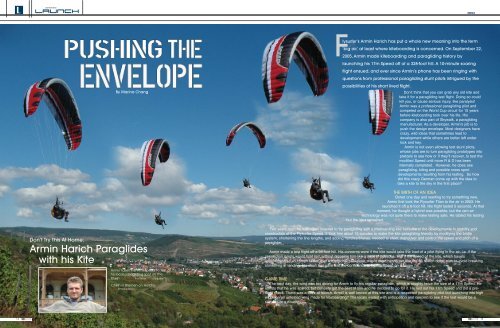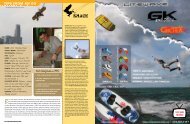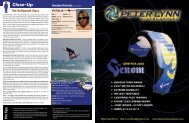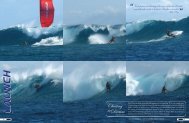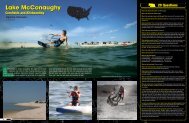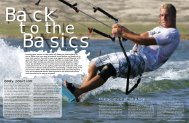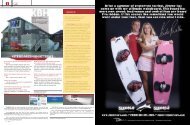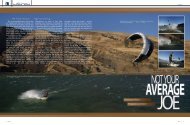Armin Harich Paraglides with his Kite - Kitesurfarea.com
Armin Harich Paraglides with his Kite - Kitesurfarea.com
Armin Harich Paraglides with his Kite - Kitesurfarea.com
You also want an ePaper? Increase the reach of your titles
YUMPU automatically turns print PDFs into web optimized ePapers that Google loves.
L<br />
DEPARTMENT<br />
<br />
HARICH<br />
By Marina Chang<br />
Flysurfer’s <strong>Armin</strong> <strong>Harich</strong> has put a whole new meaning into the term<br />
‘big air,’ at least where kiteboarding is concerned. On September 22,<br />
2005, <strong>Armin</strong> made kiteboarding and paragliding <strong>his</strong>tory by<br />
launching <strong>his</strong> 17m Speed off of a 328-foot hill. A 10-minute soaring<br />
flight ensued, and ever since <strong>Armin</strong>’s phone has been ringing <strong>with</strong><br />
questions from professional paragliding stunt pilots intrigued by the<br />
possibilities of <strong>his</strong> short lived flight.<br />
Don’t think that you can grab any old kite and<br />
take it for a paragliding test flight. Doing so could<br />
kill you, or cause serious injury, like paralysis!<br />
<strong>Armin</strong> was a professional paragliding pilot and<br />
<strong>com</strong>peted on the World Cup circuit for 10 years<br />
before kiteboarding took over <strong>his</strong> life. His<br />
<strong>com</strong>pany is also part of Skywalk, a paragliding<br />
manufacturer. As a developer, <strong>Armin</strong>’s job is to<br />
push the design envelope. Most designers have<br />
crazy, wild ideas that sometimes lead to<br />
development while others are better left under<br />
lock and key.<br />
<strong>Armin</strong> is not even allowing test stunt pilots,<br />
whose jobs are to turn paragliding prototypes into<br />
pretzels to see how or if they’ll recover, to test the<br />
modified Speed until more R & D has been<br />
internally <strong>com</strong>pleted. However, he does see<br />
paragliding, kiting and possible cross sport<br />
developments resulting from <strong>his</strong> testing. So how<br />
did t<strong>his</strong> crazy German <strong>com</strong>e up <strong>with</strong> the idea to<br />
take a kite to the sky in the first place?<br />
THE BIRTH OF AN IDEA<br />
Bored one day and wanting to try something new,<br />
<strong>Armin</strong> first took the Flysurfer Titan to the air in 2003. He<br />
launched it off a 6-foot hill. His flight lasted 5 seconds. At that<br />
moment, he thought a hybrid was possible, but the ram air<br />
technology was not quite there to make testing safe. He tabled <strong>his</strong> testing<br />
but the idea remained.<br />
Don’t Try T<strong>his</strong> At Home:<br />
<strong>Armin</strong> <strong>Harich</strong> <strong>Paraglides</strong><br />
<strong>with</strong> <strong>his</strong> <strong>Kite</strong><br />
<strong>Armin</strong> takes the 17m Speed to test at<br />
<strong>his</strong> local paragliding spot on the<br />
Rhein. Location: The Rhine Lens: Flysurfer<br />
Chillin in Bremen on Holiday<br />
Lens: Andrea Simon<br />
Two years later, he was again inspired to try paragliding <strong>with</strong> a kiteboarding kite because of the developments in stability and<br />
construction of the Flysurfer Speed. It took him about 15 minutes to make the kite paragliding friendly by modifying the bridle<br />
system, shortening the line lengths, and adding handles/brakes, needed to steer, maneuver and control the speed and pitch of a<br />
paraglider.<br />
<strong>Armin</strong> made a test flight off a 98-foot hill. His concerns were if the kite would take the load of a pilot flying in the air, i.e. if the<br />
connection points would hold him <strong>with</strong>out dropping him like a sack of potatoes, and if the speed of the kite, which travels<br />
approximately 5 to 15mph faster than a traditional paraglider, would need him to run like the $6 million dollar man to avoid breaking<br />
something at landing. His short test gave him the confidence to try the Speed on a bigger hill.<br />
GAME TIME<br />
The next day, the wind was too strong for <strong>Armin</strong> to fly <strong>his</strong> regular paraglider, which is roughly twice the size of a 17m Speed. He<br />
admits that he was scared, but curiosity got the best of him and he decided to go for it. He laid out <strong>his</strong> 17m Speed and did a preflight<br />
check. There was a buzz at launch. <strong>Armin</strong> is well known at t<strong>his</strong> site and is a respected paragliding pilot but launching into high<br />
winds on an untested wing made for kiteboarding? The locals waited <strong>with</strong> anticipation and concern to see if the test would be a<br />
success or a disaster.<br />
14 15
L<br />
<br />
<strong>Armin</strong> soared for roughly 10 minutes about 450 feet above ground level before heading out to a perfect landing. For a<br />
kiteboarder, t<strong>his</strong> is a very long time. For a paraglider pilot, it is a very short! However, he proved to himself that day that flying <strong>with</strong><br />
the Speed was indeed possible. His mind started racing about the possibilities.<br />
THE FUTURE<br />
Although paragliding has been around for over 20 years, the sport can benefit from the relatively new developments in ram air<br />
design. Stability is still an issue <strong>with</strong> paragliders and the new generation of foil kites <strong>with</strong> their closed cell technology and extreme<br />
collapse resistance could help them (paragliders) avoid deformation and loss of energy during some moves. Paragliding stunt or<br />
“acro” pilots also see the potential for a new form of flying opening up, allowing them to do super fast tricks in high winds that<br />
would normally ground them, <strong>with</strong> minimal risk of collapses. The stability of ram airs has additionally opened new doors for stunts,<br />
like Swiss stunt pilot Stefan Tobler’s recent jump from a hot air balloon <strong>with</strong> a Flysurfer Speed (check out Flysurfer’s image gallery,<br />
the photos are sick. Again, don’t try t<strong>his</strong> at home!).<br />
Flysurfer is at the very beginning of developing a hybrid kiteboarding/paragliding wing. The fact that kiteboarding and<br />
paragliding development happens under one roof at Skywalk will definitely help the process. Tests are ongoing. The first step<br />
toward a hybrid kite has already been ac<strong>com</strong>plished <strong>with</strong> the Flysurfer Taco, due to release the first quarter of<br />
2006. The patent pending Taco enables an instructor or user to transform a kite to a paragliding<br />
ground trainer wing in just one minute. But, <strong>Armin</strong> and the team at Skywalk have some good<br />
ideas for a new sport that will <strong>com</strong>bine elements of paragliding <strong>with</strong> kiteboarding.<br />
<strong>Armin</strong> says that only time will tell but hopes to pave the way to offering us some<br />
great new toys in the near future.<br />
The <strong>Kite</strong>boarder Magazine does not re<strong>com</strong>mend or condone<br />
anyone trying these types of stunts or experiments <strong>with</strong> any<br />
type of kiteboarding kite. It doesn’t take a lot of height to<br />
break your back. Don’t be a jackass.<br />
16<br />
Water, land, air or snow, <strong>Armin</strong> does it all.<br />
Location: Wasserkuppe Lens: Jens Baxmeier


